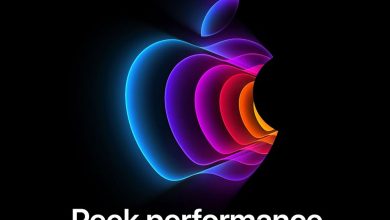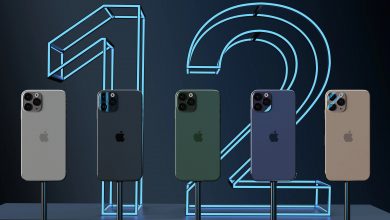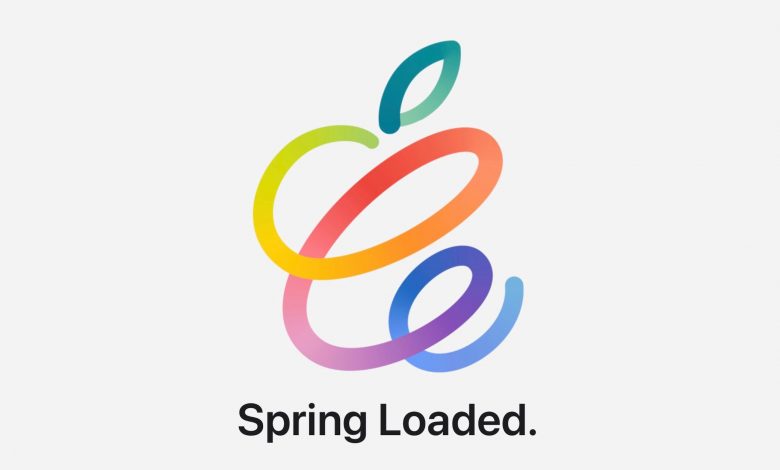
Apple’s virtual “Spring Loaded” event kicked off on 20th April at 10:00 a.m. Pacific Time. Apple debuted iPad with a mini-LED display, AirTags, iMac models based on Apple silicon, and many more things. Check out everything that Apple announced at its Spring Loaded event in a roundup below.
Apple Airtags
Apple is officially launching a Tile-like item tracker that will work with the company’s software and services. Dubbed AirTag, the small circular tag will allow you to track items within Apple’s “Find My” app on iOS. Much like Tile, Apple’s AirTags will be useful for tracking items like keys or wallets, and you’ll be provided with notifications when you’re separated from your item.
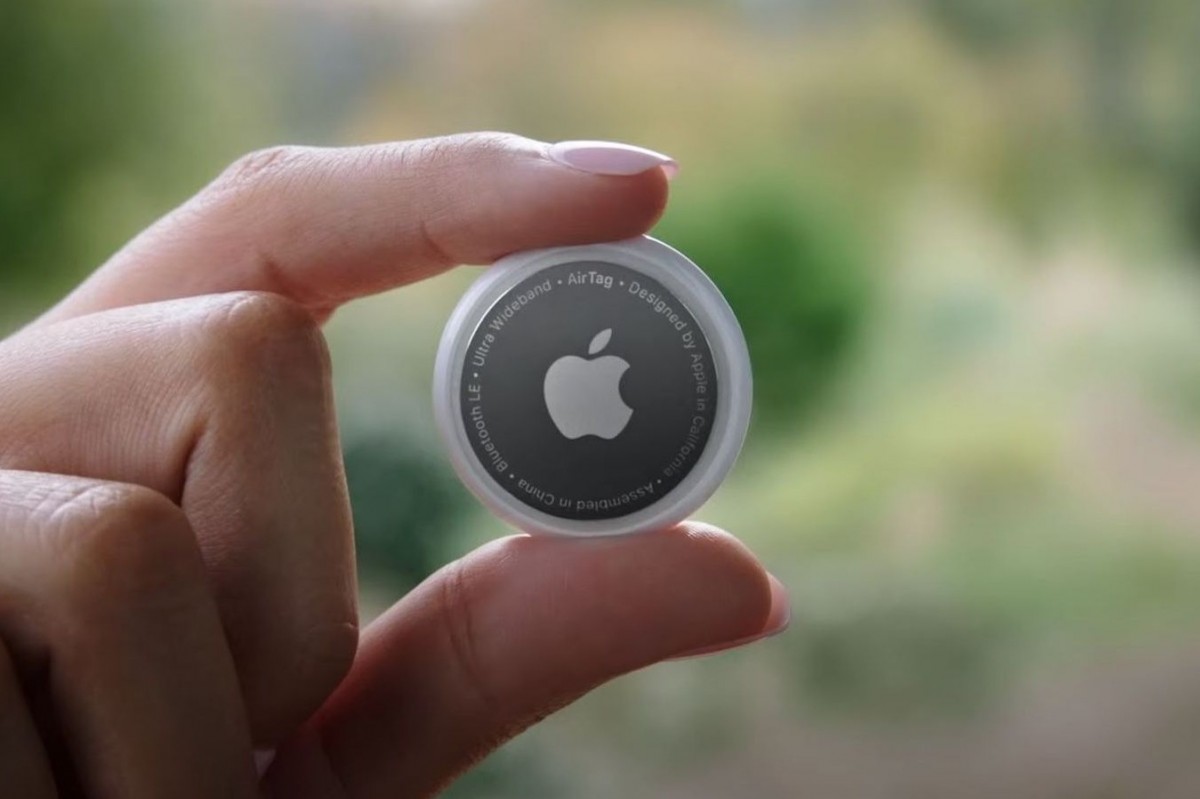
The AirTag itself is a small puck-like device that includes a built-in speaker, accelerometer, Bluetooth LE, and a user-replaceable battery. Apple says the tracker should last for a year of battery life, and you can use an NFC tap to activate a lost mode.
AirTag will be available for $29 on April 30th, or $99 for a four-pack of the devices. Preorders begin this Friday at 5AM PT / 8AM ET. Apple has also created leather loop and key ring accessories that the AirTag can slot into, and the company is also working with accessory makers to create luggage tag enclosures for the AirTag itself.
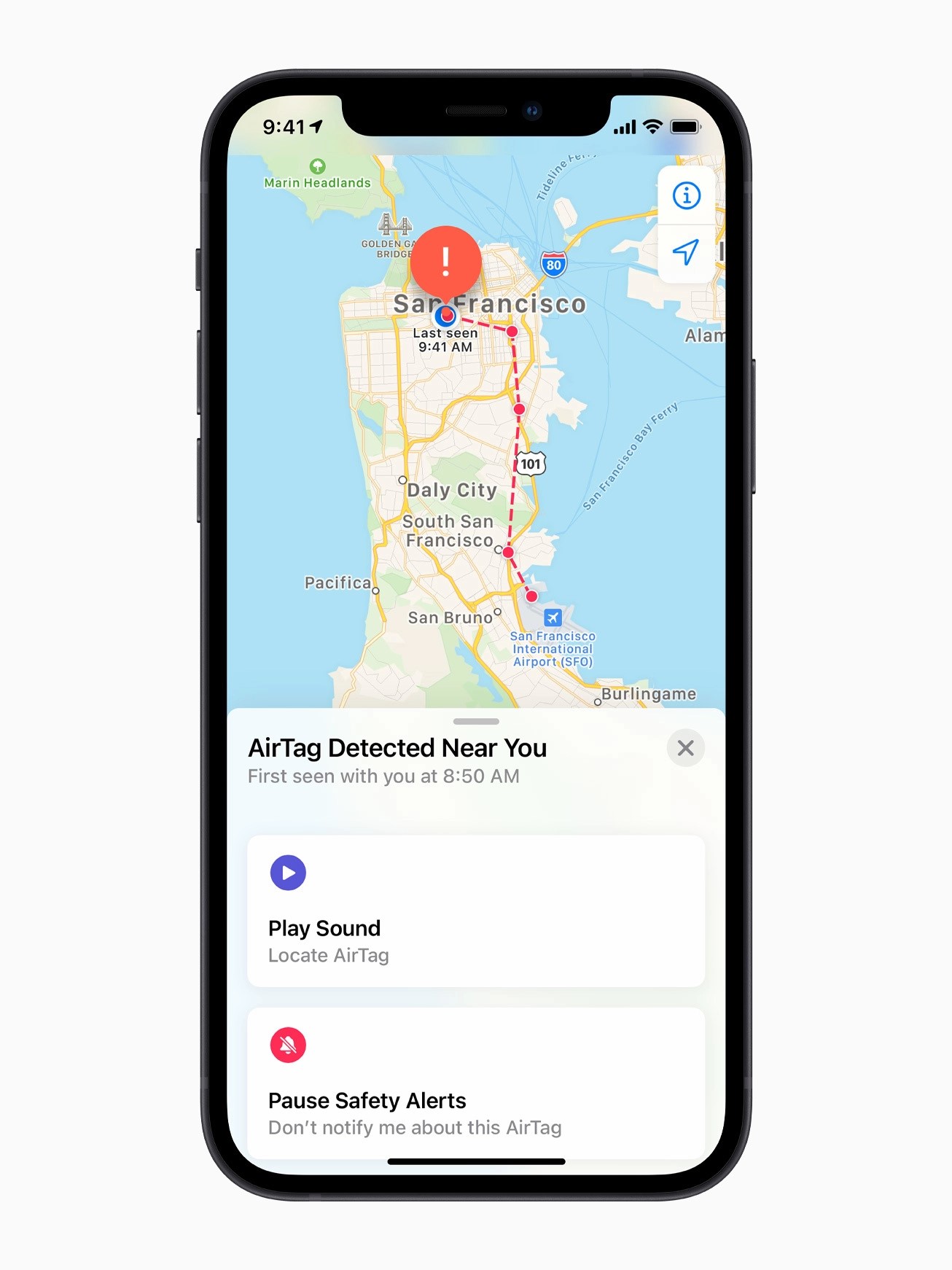
AirTags will show up in Apple’s Find My app, and the app will play a sound on the tracker when you attempt to locate an item. Each AirTag is also equipped with Apple’s U1 chip that uses Ultra Wideband technology, sound, and haptic feedback to guide people more precisely to where an item is located.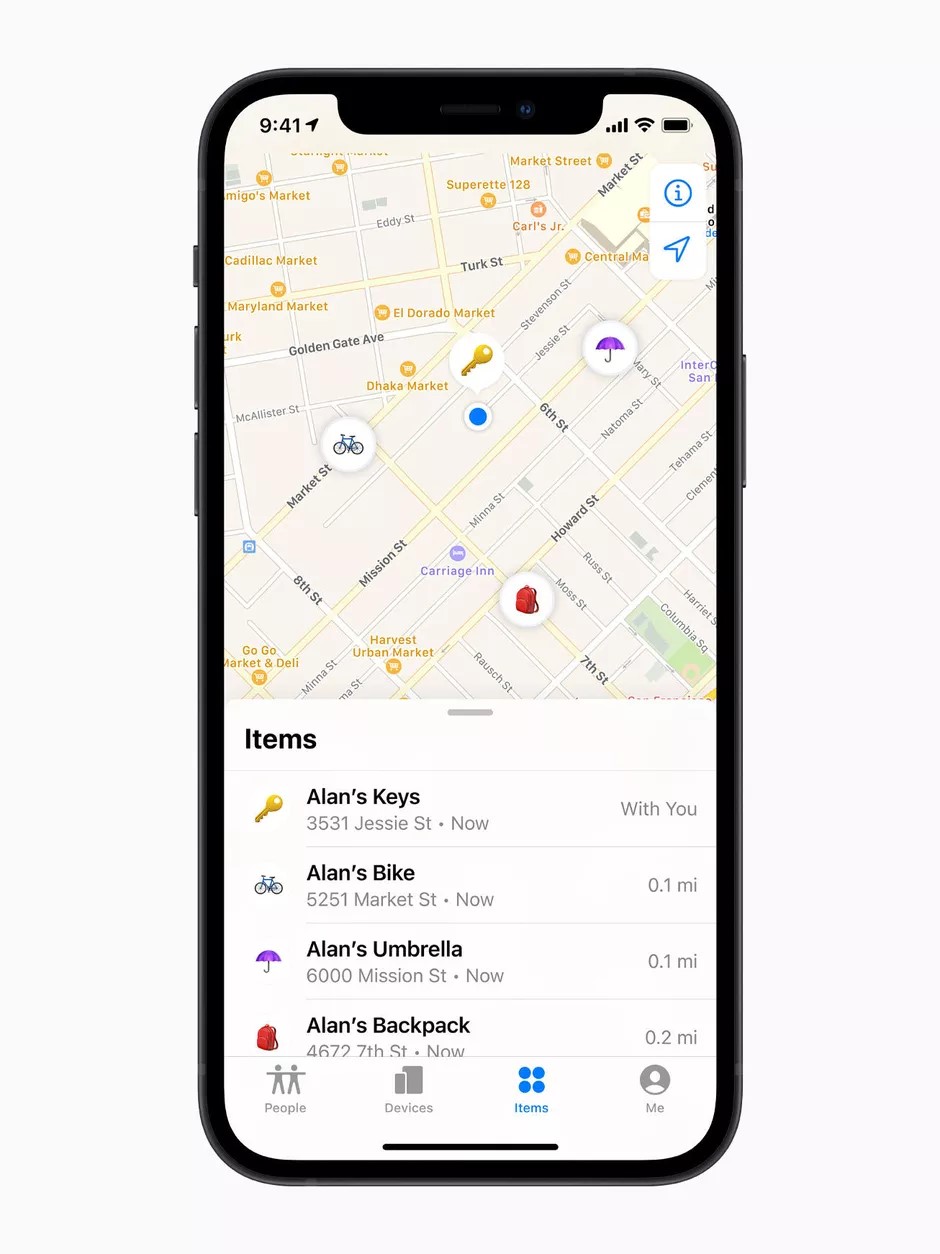
AirTags don’t store any location data or location history inside the physical device, and Apple says it’s using end-to-end encryption for the communications between an AirTag and the Find My network.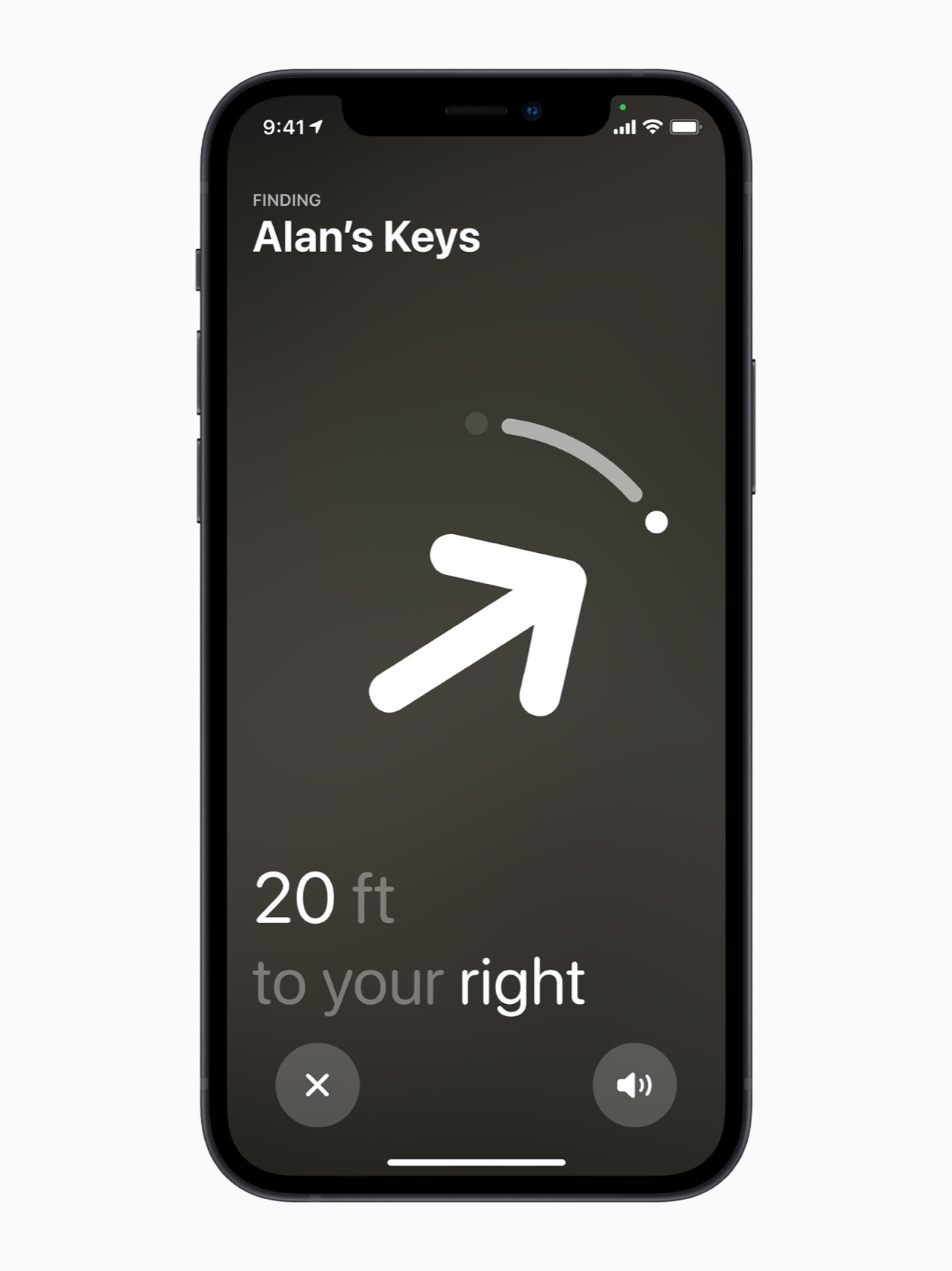
Details about AirTags first appeared in copies of the iOS 13 beta nearly two years ago, and the AirTags name was also spotted in iOS 13.2. Apple accidentally confirmed the AirTags name in a deleted support video last year, too. Following the rumors, it has taken Apple a considerable amount of time to make AirTags a reality.
A ‘Purple’ iPhone 12
The iPhone 12 palette is getting a new hue – purple. It will be available for the iPhone 12 and iPhone 12 mini, which were always more colorful than their Pro counterparts.

Pre-orders for the new color start this Friday, the first units will be available on April 30. Apple took pains to match the color of the aluminum frame to that of the back glass panel.
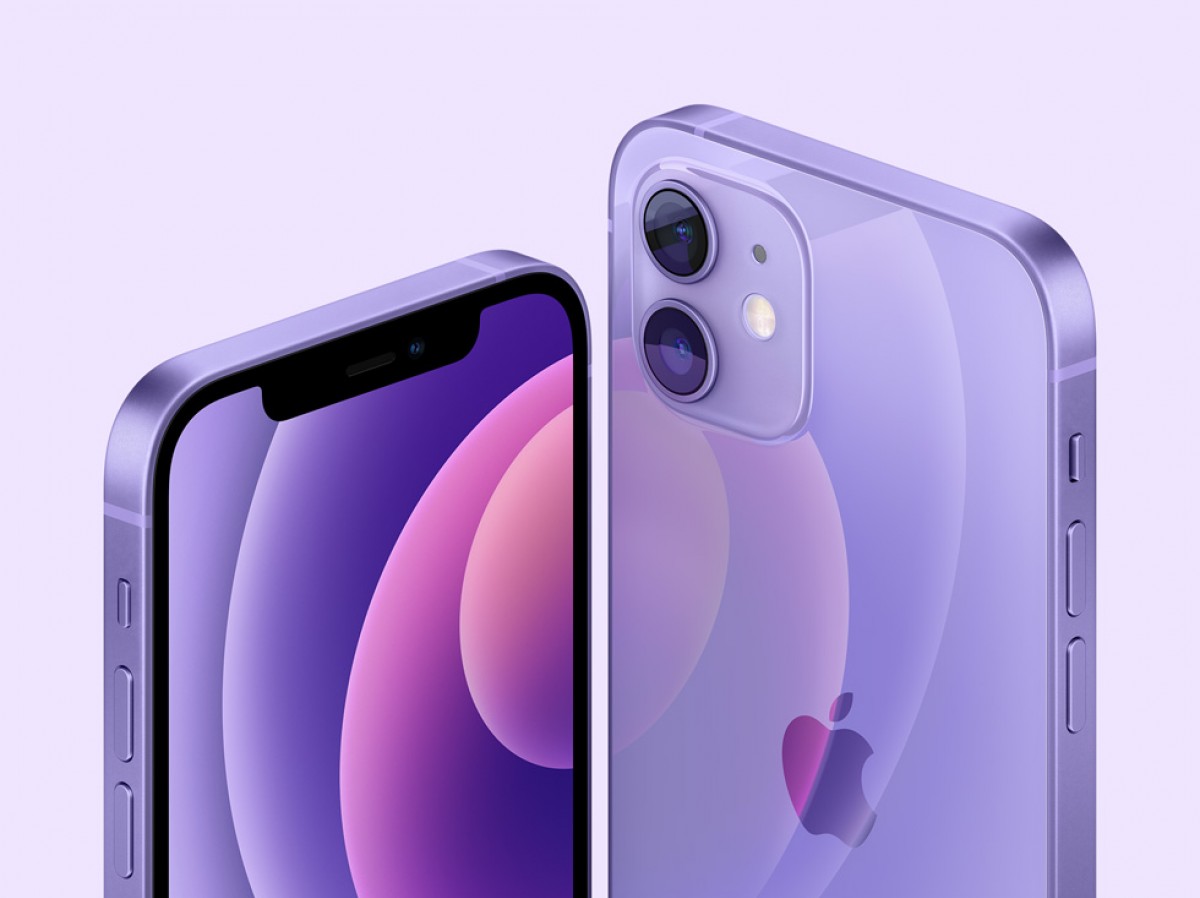
And all that care and attention to color perfection can’t be thrown away by using the wrong case, oh no. Apple is also launching a new MagSafe Leather Case and a new Leather Sleeve in Deep Violet.
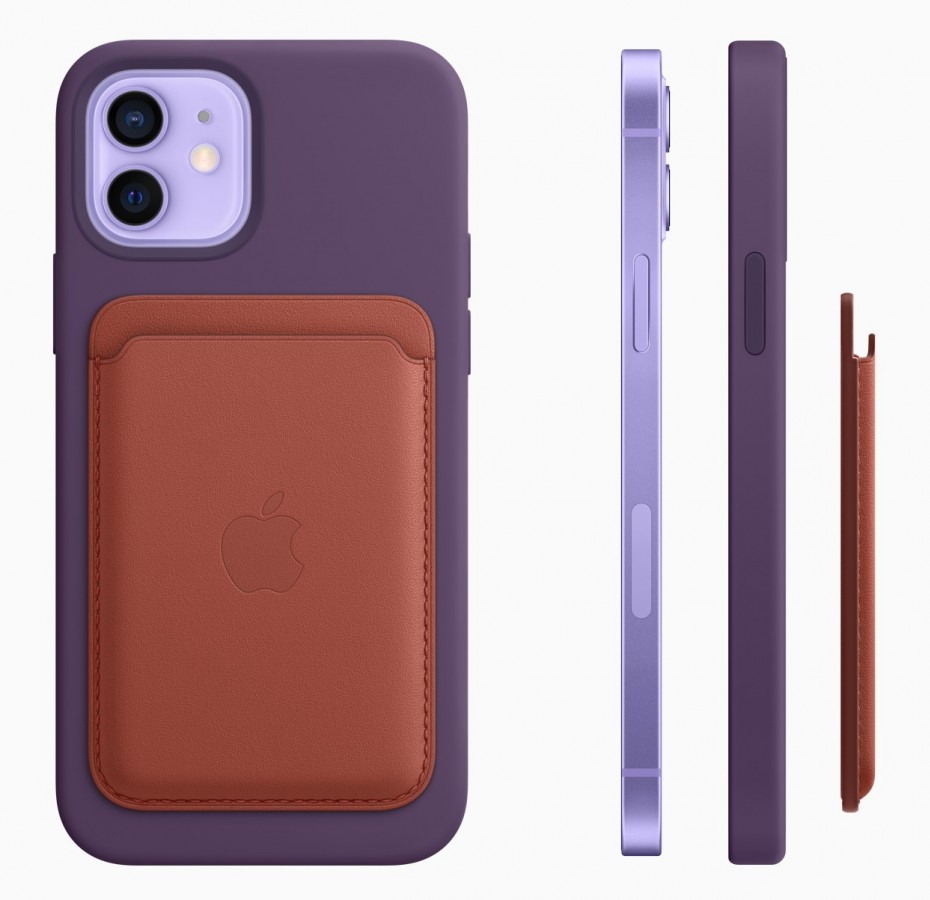
There are new silicone cases too, available in Capri Blue, Pistachio, Cantaloupe and Amethyst. And a new Leather Wallet with a color dubbed Arizona.
Apple TV 4K
Apple TV 4K now runs on the Apple A12 Bionic chipset. This is a custom Apple-designed silicon that first appeared on the iPhone XS and XR series. It’s a six-core design with two high performance and four power efficient CPU cores along with a quad-core GPU.

This has allowed the Apple TV 4K to be able to playback 4K HDR video in 60fps. Users can now AirPlay the 4K 60fps Dolby Vision videos shot on their iPhone 12 directly to the Apple TV 4K. Apple is also working with FOX Sports, NBCUniversal, Paramount+, Red Bull TV, and Canal+ to support their high frame rate HDR content.
The company is also introducing a new Siri Remote for the new model. The previous remote was often the most criticized aspect of the Apple TV experience as it was hard to tell if it was the right way up in the dark due to its symmetrical design.

The new model fixes that with a brand new design that should be easy to use even in the dark. The flat touchpad has been replaced with a circular direction pad with five way physical controls. The surface is touch sensitive and you can also swipe on it to navigate through the UI. Moreover, users can also run their fingers around the ring to scrub through content like the click wheel on the iPod. The Siri button has been moved to the right side. The remote now also features mute and power button to directly control your television, so you don’t need to use the TV remote.
Apple has also incorporated a clever color calibration feature that takes advantage of the sensors on your iPhone. All you need is an iPhone with Face ID running iOS 14.5. The way this works is that you start the Color Balance feature and then hold the front of your iPhone within the marked area on your screen. After a few seconds, the process is complete.
The new Apple TV 4K is priced at $179 and will be available to order beginning Friday, April 30, with availability starting second half of May. It will be available in more than 30 countries and regions.
Apple will also be selling the old Apple TV HD with the new Siri Remote for $149. The new Siri Remote can also be purchased independently for $59 and is compatible with current Apple TV 4K and Apple TV HD models.
Redesigned iMac with M1 Chip
Apple’s in-house M1 chipset for computers is no longer confined to MacBooks and the Mac mini. This is a very colorful Mac – in fact, it will be offered in seven different hues: green, yellow, orange, pink, purple, blue, and silver. It comes with Apple’s ARM-based chip, with eight CPU cores and 7 or 8 GPU cores depending on which configuration you pick, but there are a lot of other upgrades too.
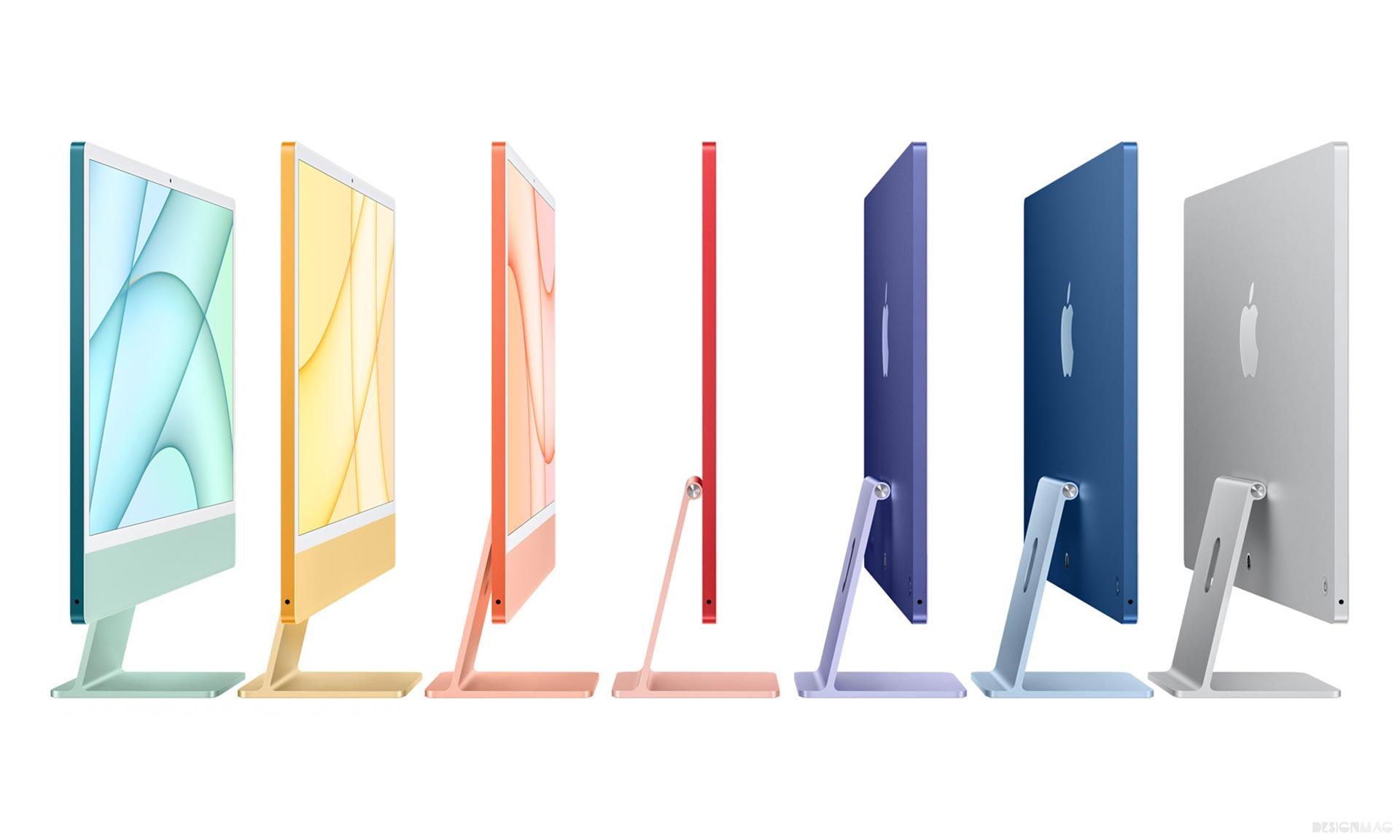
For example, the webcam is 1080p, it has six speakers built-in, including two pairs of force-cancelling woofers, supporting spatial audio with Dolby Atmos, and a three-mic array of “studio quality”. The mics are specially positioned to reduce interference from the rest of the system, and they have directional beamforming too.
The computer is only 11.5 mm thick, and the screen 23.5″ 4.5K Retina Display with 11.3 million pixels, 500 nits of maximum brightness, P3 1B color support, and True Tone technology to adjust color temperature automatically based on your surroundings. There’s also an “industry-leading” anti-reflective coating.
The M1 chipset enables up to 85% faster CPU performance and up to 50% better GPU performance than the most powerful discrete graphics in the fastest old 21.5″ iMac. In some apps, the GPU is actually twice as fast as in the previous small iMac model, and you also get 3x faster machine learning.

Every new iMac has two Thunderbolt ports and Wi-Fi 6. The more expensive version offers two additional USB-C ports and also has a 1Gbps Ethernet port, which is somewhat strangely placed in the brick of the power adapter. Speaking of which, the cable that goes from that adapter to the computer attaches magnetically, in a neat touch.
Speaking of touch, you can get a color-matched Magic Keyboard with Touch ID for your new iMac, in the world’s first wireless implementation of the biometric authentication system. The keyboard has a dedicated security chip that communicates directly with the Secure Enclave in the M1, creating an end-to-end encrypted channel for your fingerprint data.
The new iMac with M1 (8-core CPU and 7-core GPU) starts at $1,299 in four colors (green, pink, blue, and silver), shipping with a normal color-matched Magic Keyboard and Magic Mouse.
There’s an upsell version for $1,499 which you can have in all of the seven hues. This one has an 8-core CPU and 8-core GPU, and ships with the color-matched new Magic Keyboard with Touch ID and a Magic Mouse. Both iterations have 8GB of RAM and a 256GB SSD. You can upgrade the cheaper version to 512GB or 1TB of storage though, while the more expensive one can get optional 16GB of RAM and up to 2TB of storage.
The new iMac with M1 will be up for pre-order on April 30, and will begin arriving to customers in the second half of May.
New iPad Pro with Liquid XDR mini-LED Display
The Apple iPad is unquestionably one of the best tablets you can buy. Despite the global decline in demand for tablets, different varieties of the iPad have been in high demand thanks to their unique proposition of powerful processing capabilities and portability. The iPad Pro takes it a step further with a massive display, multiple cameras on the back, pro-grade performance, and the Apple Magic keyboard that will make you want to replace your laptop with it. Apple announced the iPad Pro 2021 at its Spring Loaded event on April 20th, 2021, with a suite of improvements including an all-new Apple M1 chip, a new mini LED display, up to a whopping 2TB of storage, and 5G connectivity. At this event, Apple also announced a new and highly improved iMac, a new purple iPhone 12, AirTags, as well as the new features making their way to iOS 14.5.
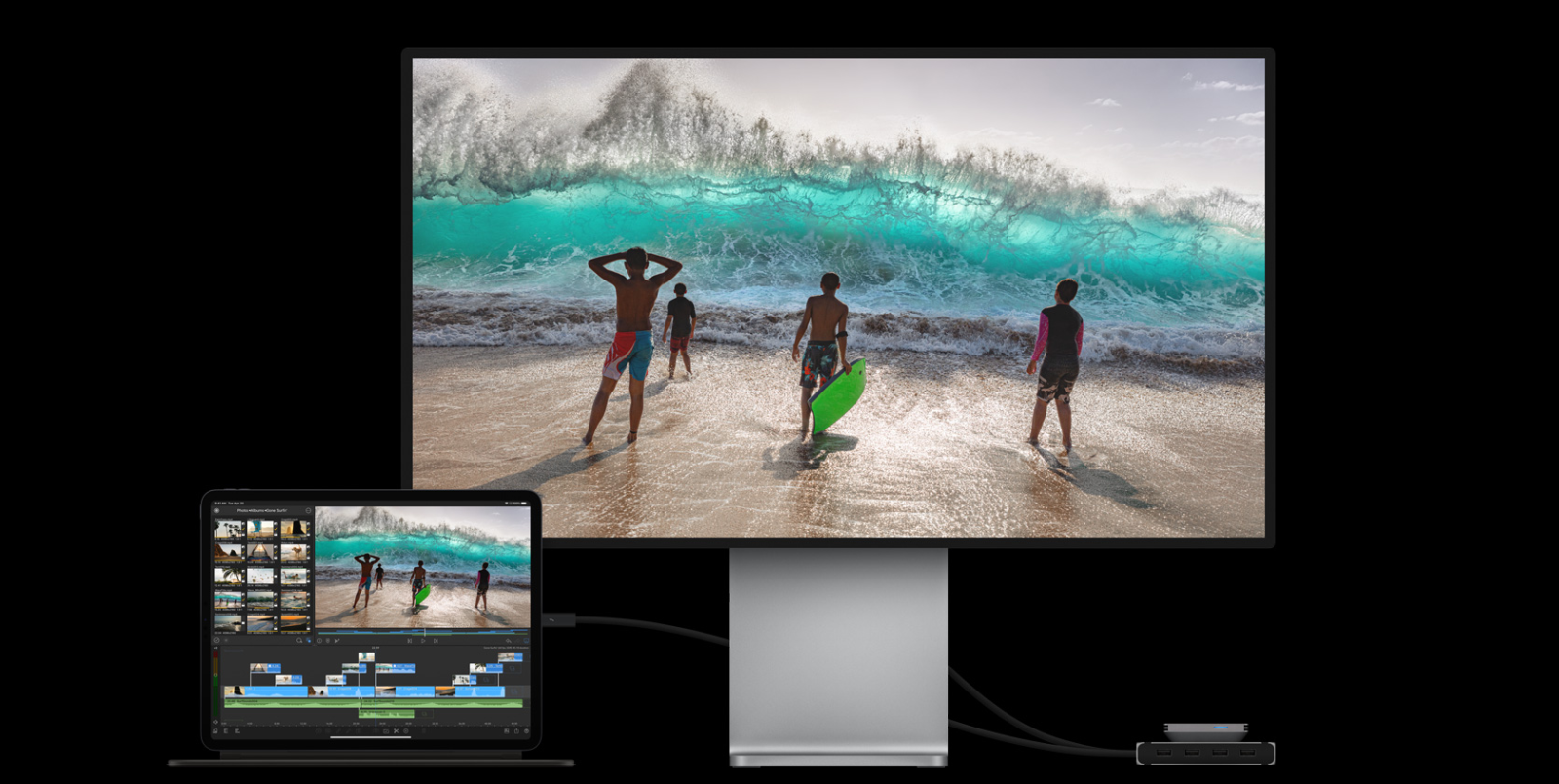
The new iPad Pro gets the same chipset as the MacBook Air, some 13″ MacBook Pro variants, the Mac Mini from 2020, and the new 2021 iMac. The Apple M1 is the company’s in-house ARM-based SoC that is designed to replace the x64 chips from Intel and AMD on computers. By using the same chip on the iPad Pro 2021, Apple further fills up the performance gap between the iPad Pro and the MacBook and other devices. Other than offering a performance that is comparable to Apple’s M1 MacBook laptops, the iPad Pro 2021’s USB-C port has been updated with Thunderbolt support.
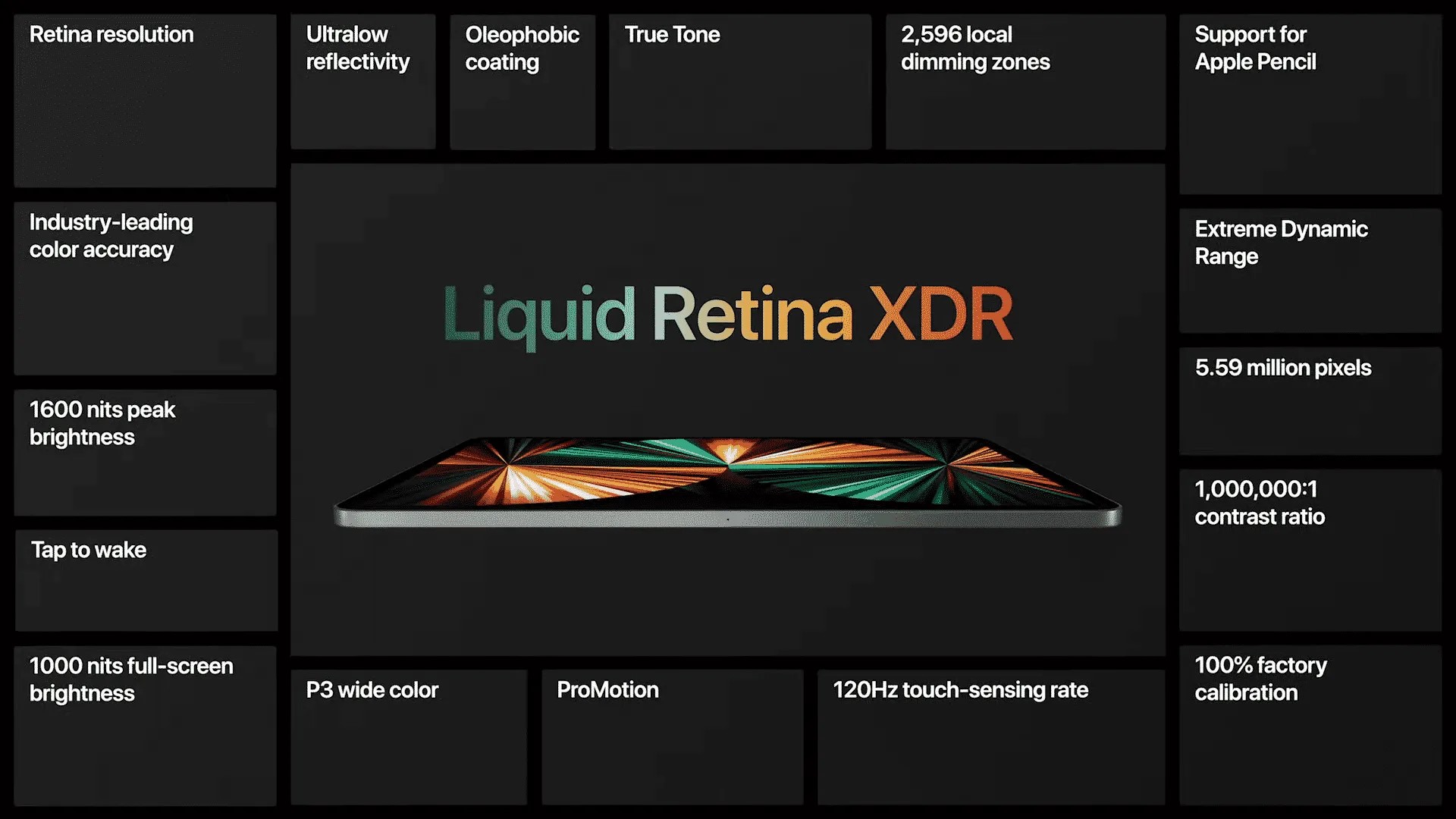
Apple iPad Pro 2021 variants
The iPad Pro 2021 comes in two display sizes — 11-inch and 12.9-inch. As noted previously, there are no major changes when it comes to the appearance of the new tablets. There are, however, major changes under the hood. Other than the changes over the previous generations, the two variants of the new iPad Pro also differ in terms of display technology. The bigger iPad Pro features a 12.9-inch Mini LED display while the smaller one comes with an 11-inch LED display. Other than this difference between the types of displays — and the dimensions of the two models, the two variants are identical.
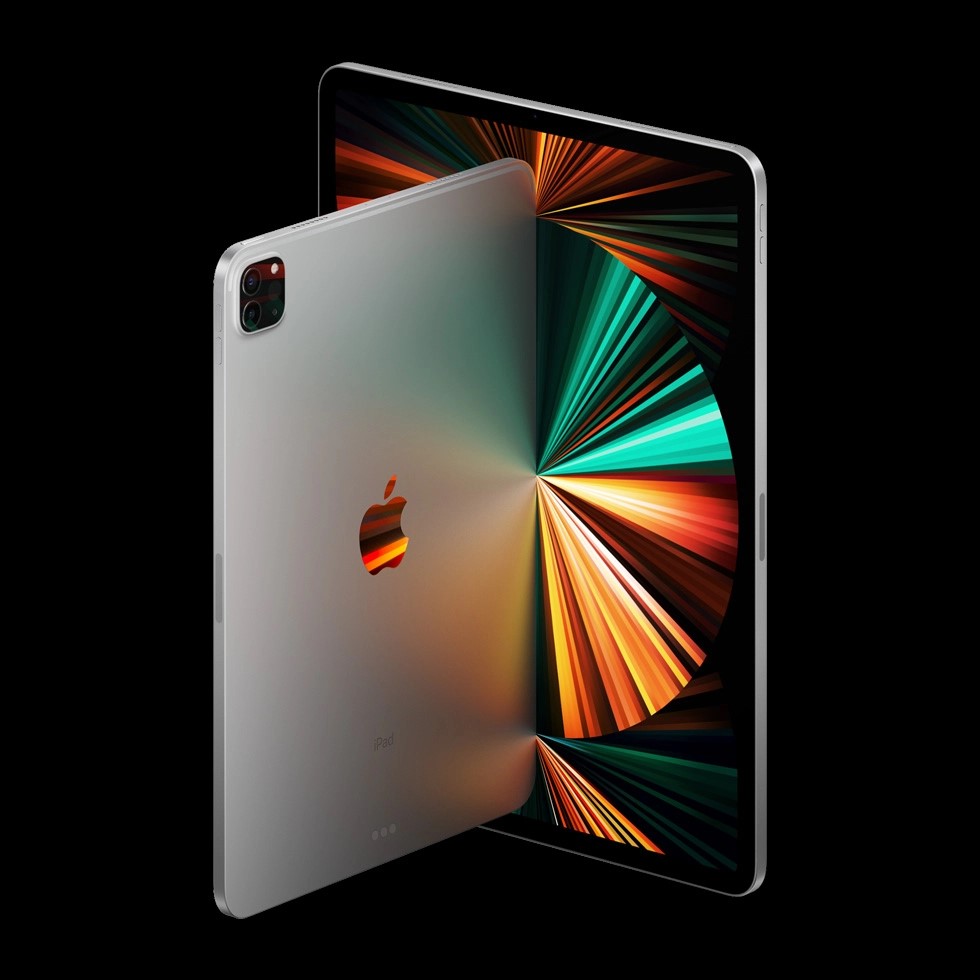
Mini LED display on iPad Pro 2021
The iPad Pro 2021 features several enhancements, and the display is among the first ones you will notice. As reported by multiple sources ahead of the launch, the iPad Pro is equipped with a Liquid Retina XDR display, which is the moniker used by Apple to denote the new Mini LED display. As remarked by Apple analyst Ming-Chi Kuo (via MacRumors) and later corroborated a Bloomberg report, only the larger model out of the two — i.e. the 12.9-inch iPad Pro 2021 — gets the new display while the smaller 11-inch iPad Pro retains the older Liquid Retina display.
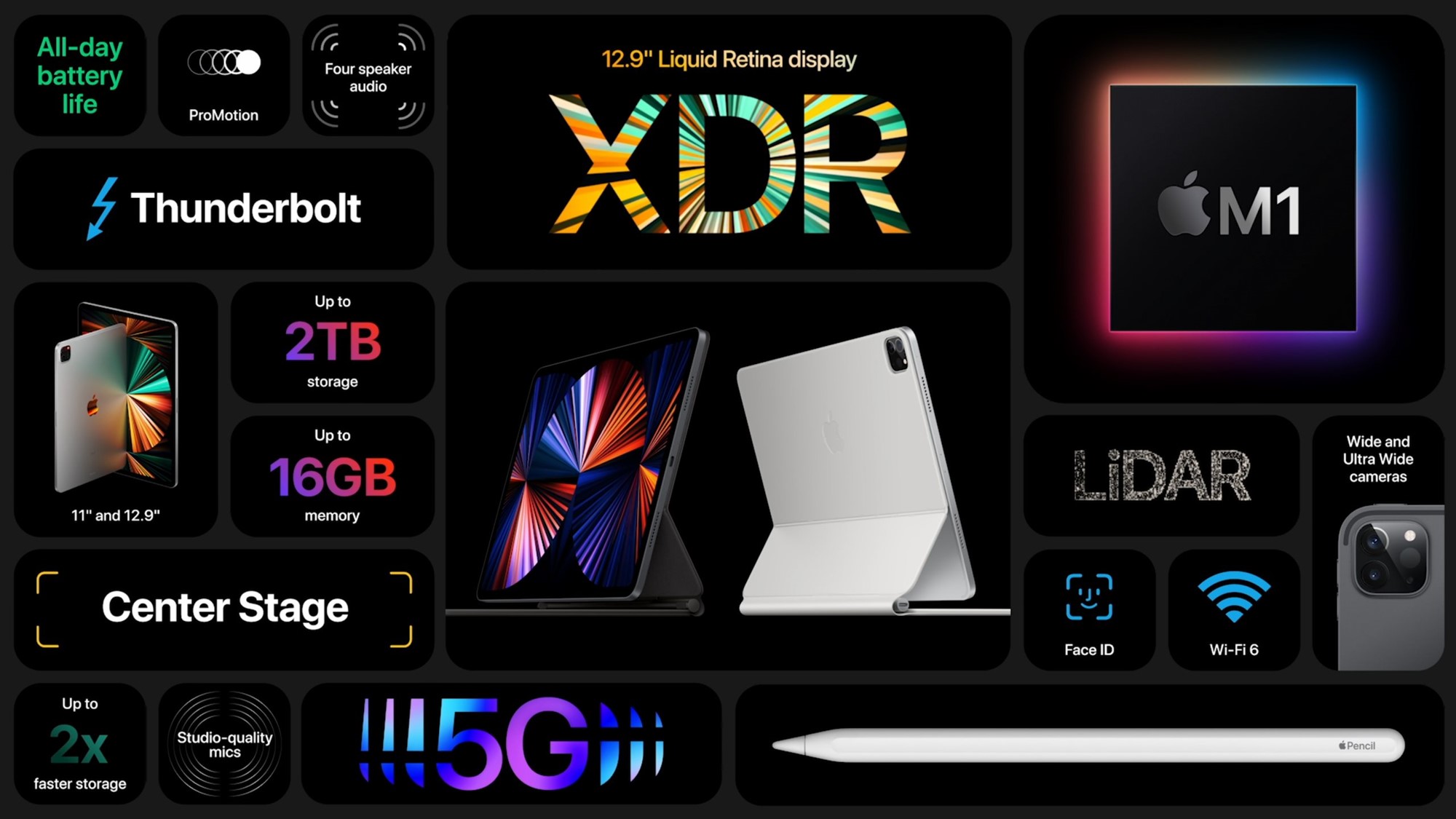
Mini LED is a variety of LCD panels in which — yes, you guessed it right — miniature LEDs (with size in the range of 100-200μm) are used as the backlight source. These miniature LEDs are nearly 120X smaller in volume than the ones usually used to power regular LED-backlit LCDs. Owing to their smaller size, a Mini LED panel utilizes thousands of these Mini LEDs. Apple’s Liquid Retina XDR display employs over 10,000 Mini LEDs.
The 12.9-inch iPad Pro 2021’s display has a resolution of 2732 x 2048 pixels, with a 1000-nits brightness. The display on the smaller 11-inch variant, on the other hand, has a resolution of 2388 x 1688 pixels with a 600-nits brightness.
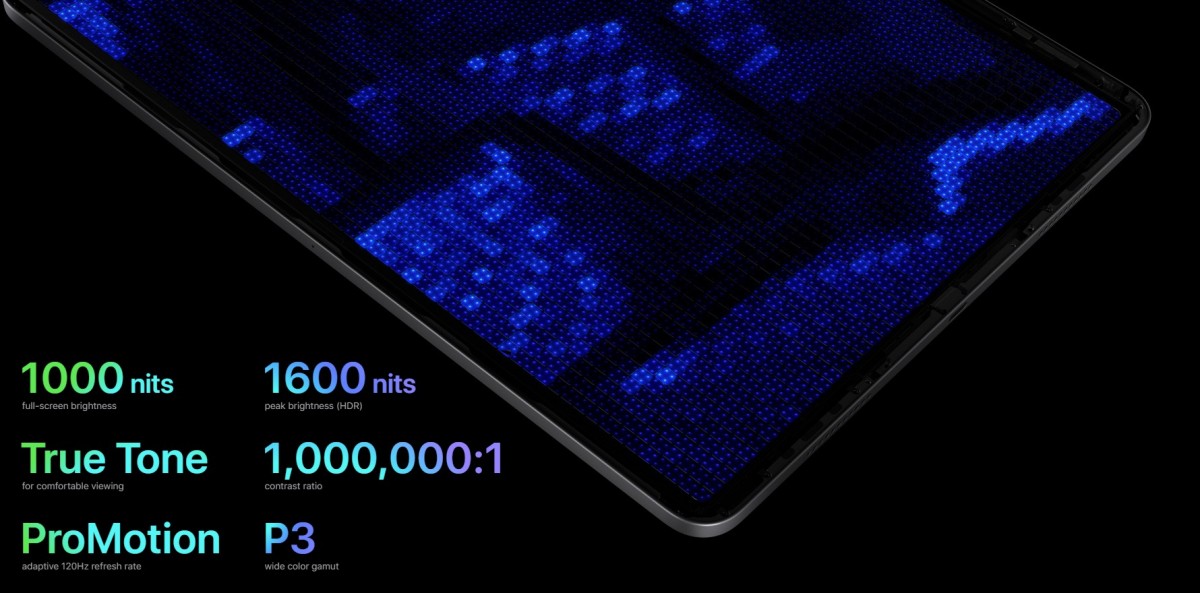
Apple M1 processor on iPad Pro 2021
Ahead of the launch, 9to5Mac had spotted references to Apple’s A14X Bionic chip — a souped-up version of the A14 Bionic that powers the iPhone 12 series and the iPad Air 2020 — in the source code of iOS 14.5 beta. This purported chip was believed to be based on Apple’s custom ARM-based M1 chipset that powers the 2020 MacBook Air Mac Mini and some of last year’s 13” MacBook Pro models. The A14X Bionic was believed to be as powerful as the M1 chip, and Bloomberg’s Mark Gurman has substantiated the same.
These leaks were, however, proved partially wrong when Apple announced the iPad Pro 2021. The new iPad Pro runs on Apple’s M1 chipset instead of the rumored A14X Bionic, and this news comes as a pleasant surprise. The M1 SoC system-on-chip is designed on the same principle as the A-series Bionic chips that have powered the iPhones and iPad for some years and its system-on-chip design instead of separate chips for CPU, GPU, RAM, flash storage, etc.
The Apple M1 chip promises significant performance gains over the A12Z Bionic chip used in last year’s iPad Pro. Apple claims a 50% improvement in CPU performance as well as a 40% gain in GPU performance. The M1 chip features an 8-core CPU, an 8-core GPU, and a 16-core NPU. There is a choice between 8GB and 16GB of RAM with the option to choose up to 2TB of flash storage.
Last year, Apple had announced its plan to replace the x64 chips from Intel and AMD on the Mac lineup with its own M1 SoC. By announcing the iPad Pro with the same chipset as its computers, Apple is further solidifying the idea that an iPad Pro is no less than a Mac, unlike Android tablets which still miserably lag behind PCs in terms of performance. The utilization of an Apple M1 chip on the iPad Pro means that apps that can run on the Macs with ARM chips will also be available to work on the iPad Pro (given support from developers). With this, the iPad Pro becomes a great alternative for anyone who wants a MacBook Air but with the convenience of a touch screen and Apple Pencil input.
The new iPad Pro also borrows one feature from the iPhone 12’s A14 Bionic chip and that’s 5G connectivity
5G cellular connectivity on iPad Pro
The iPad Pro 2021 is the first iPad to get 5G connectivity. The new iPad Pro supports mmWave bands for 5G connectivity in the US, and Apple claims download speeds of up to 4Gbps. Apple also claims the iPad Pro has support for the widest range of 5G bands. Along with 5G connectivity, the new models also support eSIM alongside a physical nano SIM, but you will not be able to use this cellular connection for calling.
Note that you will have to pick a Wi-Fi+Cellular model to enjoy 5G on the iPad Pro and will be required to pay your carrier for active 5G services.
New Camera with “Center Stage”
The TrueDepth camera system on the front of the iPad Pro 2021 now features a 12MP selfie camera with an ultra-wide field of view spanning 122°. This enables a new feature called “Center Stage” which keeps the users in the center of the frame by zooming in and panning the viewfinder as they move. All of this happens with the help of M1’s machine learning abilities and without any physical movement in the camera. When more than one user enters the scene (or is already present), the camera automatically zooms out to accommodate a large group of people.
While the rear cameras on the iPad Pro remain unchanged, the improved ISP on the Apple M1 chip allows for better image processing and brings Smart HDR 3, which was previously exclusive to the iPhone 12 lineup. The feature uses machine learning to tune your images to ensure the best possible picture quality. Additionally, the LiDAR sensor on the iPad Pro helps in improving focus when capturing images in low light.
New Features
Alongside the improved display and the better processor, Apple has also replaced the standard USB Type-C port on the iPad Pro with one that supports Thunderbolt, a technology that has been available on Apple’s Mac computers, including MacBook Pro, MacBook Air, Mac Mini, iMac, and the Mac Pro since 2016.
Thunderbolt is an open and multipurpose data and power transfer standard developed by Intel. It allows storage devices such SSDs, DisplayPort-supported external monitors, and PCIe peripherals such as external graphics cards or network connectors over a USB Type-C port. Thunderbolt 3 supports transfer speeds of up to 40Gbps, i.e. four times the transfer speeds of a USB 3.1 port.
Design
While no explicit leaks exposed the iPad Pro 2021 models in press renders or other conspicuous forms, a set of 3D CAD renders shared by 91Mobiles had revealed there would not be any major changes to the design. The same has been confirmed with the official launch with the new iPad Pro barely changed from the last generation.
Apple also claims the new iPad Pro is designed with 100% recycled aluminum as well as 100% recycled rare earth elements used to make the magnets on the iPad Pro. This is in line with the tech giant’s commitment to helping the environment. Apple claims that its global corporate operations are carbon neutral and it envisions to have “net zero climate impact across the entire business” by 2030.
iPadOS 14.5
Apple also announced that iOS 14.5 and iPadOS 14.5 will start rolling out starting next week with support for AirTags, more gaming controllers, new languages in Apple Pencil features such as Smart Selection and Scribble, additional emojis, and the option to share lyrics as well as sort top songs by cities in Apple Music.
Accessories for iPad Pro 2021
While the rumored Apple Pencil with a longer tip and color sampling support did not see the light of the day, the company did release its Magic Keyboard in white color to complement the already existing black one. The new white color complements the Apple Pencil, which only comes with white color and could be a good choice for anyone who does not fancy black.
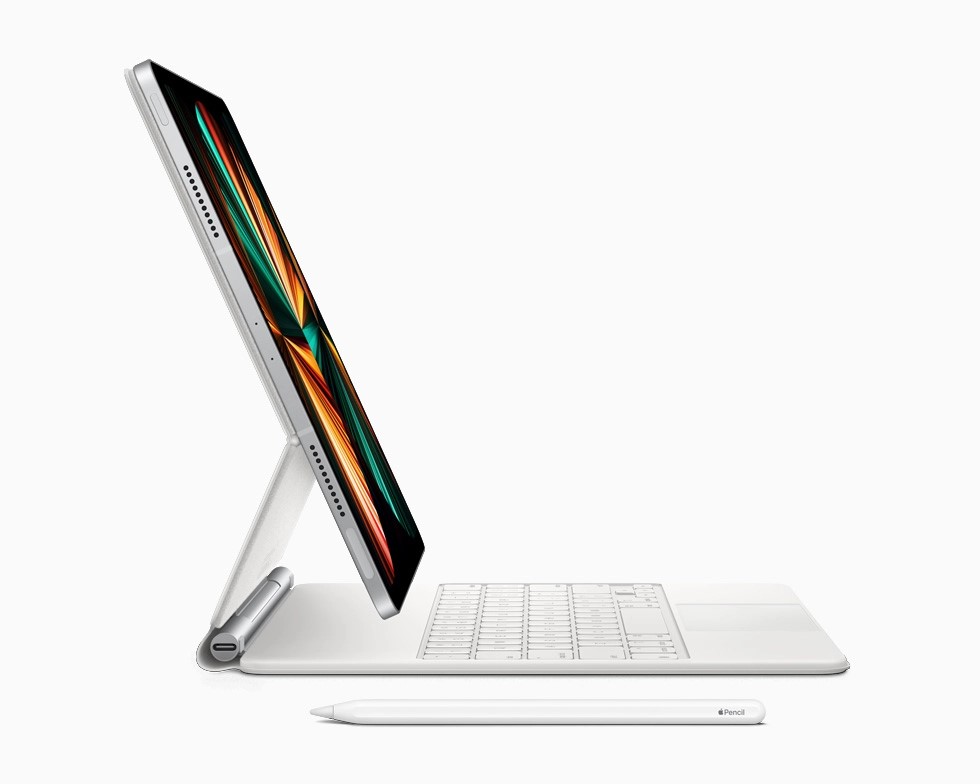
Apple iPad Pro: Pricing
Despite the improvement in performance, the 11-inch iPad Pro 2021 comes at the same price as the previous year’s models. It costs $799 for the Wi-Fi-only model, while the Wi-Fi + Cellular model has a starting price of $999. It goes all the way up to $2,099 for 2TB of storage and support for 5G connectivity alongside Wi-Fi.
Meanwhile, the 12.9-inch model is available at a starting price of $1099 for 128GB storage and only Wi-Fi. You will have to pay $200 additionally for the cellular variant with 5G support. The most amped-up variant of the larger iPad Pro is priced at $2,399.
The Magic Keyboard for the 11-inch iPad Pro is priced at $299 while the one for the 12.9-inch variant is priced at $349 in the US. The second-generation Apple Pencil will be available for $129 in the US.
The prices of the iPad Pro 2021 may vary as per market, accounting for different taxes.
iPad Pro 2021: Availability
Even though some early rumors pointed to a launch on March 23rd, the official launch actually happened a month later i.e. on April 2oth. The delay may or may not be related to the shortage of Mini LED panels pointed out by Nikkei Asia and Bloomberg. Both of the news outlets had reported that although Apple would launch the new iPad Pro later in April, the actual units will start shipping next month or later.
This stands true as the iPad Pro 2021 will be available to order via Apple’s online and offline stores starting April 30th and will be available starting the second half of May.
Apple Card Family
The Apple Card got official two years ago as the company’s first foray into the financial services market – with a credit card, no less. Today at its special event, Apple announced an expansion of the Apple Card into your Family Sharing group.
That’s right, starting in May, if you’re in the US, you will be able to share your Apple Card with those you have in your Apple Family Sharing group, up to five people. They have to be 13 or older.
If you have a special someone in your life who’s 18 or older, you can invite them to be a co-owner of your Apple Card. This lets both of you build credit history together, and you also get the flexibility of a combined credit limit and “transparency into each other’s spending”, which may be a bug or a feature depending on how you view things. And life.

Anyway, Apple says the co-owner thing also allows people to “share the responsibility of making payments”, because everything needs to be shared now. Can’t wait for Stories about this to pop up somewhere in the future.
Existing Apple Card customers can merge their accounts if they want to get the flexibility of a higher shared credit limit while keeping the lower APR of the two accounts.
Apple’s cashback program (Daily Cash) will work for co-owners and other people you share your Apple Card with (those who are in that position but aren’t co-owners are called participants in Apple parlance).
For participants, the owner (or co-owners) can set spending limits and there are also some “controls to help teach smart and safe financial habits”, so the best fitting people to the participant role are probably one’s children.
Apple Podcast Subscription Service
Today at its Spring Loaded event, Apple introduced Podcasts Subscriptions. While the name of this service really doesn’t roll off the tongue, it is incredibly self-descriptive.
Starting in May, people in more than 170 countries and regions will be able to sign up for premium subscriptions to their favorite podcasts. These will include “a variety of benefits curated by creators, such as ad-free listening, access to additional content, and early or exclusive access to new series”.

Initially, premium subscriptions will include Tenderfoot TV, Pushkin Industries, Radiotopia from PRX, QCODE, NPR, the LA Times, The Athletic, Sony Music Entertainment, and more.
Also from May, Apple Podcasts will get channels, which are groups of shows curated by creators. These have unique titles, descriptions, and artwork. There will be free channels, paid channels, and channels with additional benefits for subscribers.
A redesigned Apple Podcasts app arrives with iOS 14.5, with an enhanced Search tab that gives you quick access to Top Charts and categories. There are also new pages for every show and episode, making it easier to follow, listen, and share. The Smart Play button will automatically start you from the latest episode for episodic shows, and from the beginning of each series for serialized productions. You can also save individual episodes for offline playback.
RC Versions of Software
Apple just announced a bunch of upgrades for the iMac, iPad Pro, Apple TV 4K, and much more, Other than this, Apple has also seen fit to release the RC version of iOS 14.5 and iPadOS 14.5, macOS Big Sur11.3, watchOS 7.4, and tvOS 14.5 to developers for testing purposes. The RC builds arrive a week after the previous beta was released.
If you are a developer, you can download the new RC build of iOS 14.5 and iPadOS 14.5, macOS Big Sur11.3, watchOS 7.4, and tvOS 14.5 on your compatible devices right now. Just make sure that you have installed a proper configuration profile from the Apple Developer Center.
iOS 14.5 and iPadOS 14.5
The RC build of iOS 14.5 and iPadOS 14.5 can be downloaded on your compatible iPhone and iPad models from the Apple Developer Center. iOS 14.5 and iPadOS 14.5 are the biggest updates the firmware has received since it was announced last year. The builds arrive with a plethora of new features like the new ‘Unlock with Apple Watch’ feature, The update also brings global 5G support in Dual-SIM mode on iPhone 12 models. Support for PlayStation 5 DualSense Controller, Xbox Series X, and Series S Controller, and much more.
macOS Big Sur 11.3
Other than iOS 14.5, Apple has also released the RC build of macOS Big Sur 11.3 to developers. If you are a developer, you can download the latest build from the Apple Developer Center after installing a proper configuration profile. Simply head over to the Software Update mechanism in System Preferences. The RC build of macOS Big Sur 11.3 brings forth a bunch of new additions as well, like optimizations for iOS Apps on the M1 Macs, customization options in Safari, Controller Emulation, Reminder app features, and much more.
watchOS 7.4
If you want to install watchOS 7.4 on your compatible Apple Watch, you first have to download the proper configuration profile from the developer center. Once you do that, simply head over to the dedicated Apple Watch app on your iPhone and then navigate to General > Software Update. Much like the iOS 14.5 RC build, watchOS 7.4 will also have a lot in store for users. For instance, the ‘Unlock with Apple Watch’ will work alongside your iPhone, and much more.
vOS 14.5
Apple has also seeded the RC version of tvOS 14.5 to developers. The build is designed for the fourth and fifth generation of Apple TV and developers can install it on their compatible Apple TV models via a profile that is installed using Xcode. tvOS 14.5 brings support for PlayStation 5 DualSense Controller, Xbox Series X, and Series S Controller so you can enjoy Apple Arcade with full might. The new build also removes mentions of Siri Remote and replaces it with Apple TV Remote. There are a bunch of other features to check out as well, so be sure to stick around,
That is all for now, folks. Apple just got done with its Spring Loaded event. How did you like it? What was your favourite announcement of the event? Let us know in the comments.


